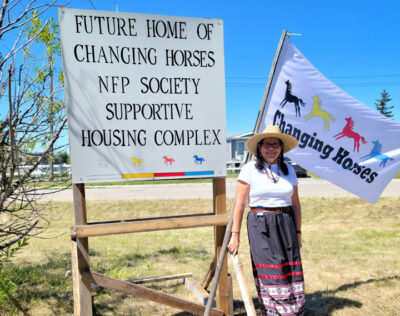Tiny homes project to help homelessness in Blood Tribe
By Tim Kalinowski on July 2, 2021.
 Submitted photo
Changing Horses NFP Society vice-president and innovation lead Katie Rabbit-Young Pine was thrilled to see her group's tiny home supportive housing complex receive a site blessing in Moses Lake this week
Submitted photo
Changing Horses NFP Society vice-president and innovation lead Katie Rabbit-Young Pine was thrilled to see her group's tiny home supportive housing complex receive a site blessing in Moses Lake this weekLETHBRIDGE HERALDtkalinowski@lethbridgeherald.com
One Blood Tribe not-for-profit society feels tiny homes might be part of the solution to homelessness on the reserve, and other First Nations across Canada, and is hoping to prove the concept works by constructing a new supportive housing complex at Moses Lake.
The Changing Horses NFP Society received an Indigenous Services Canada Indigenous Housing Innovative Initiative (IHII) grant, (one of only 24 projects chosen across Canada), in 2019 which was supposed to provide seed money to begin construction on its four unit tiny house supportive housing complex in 2020. The project was ultimately delayed by COVID-19, but is beginning to gear up again this summer.
The Changing Horses NFP Society was finally able to hold a blessing ceremony performed by local Elder Alice Wolf Child for the construction site on Wednesday morning, and will enter the final pre-planning stages for a groundbreaking in August, says the Society’s vice-president and lead innovator Katie Rabbit-Young Pine.
“We are going to have four separate homes, but all of them are going to be duplexes,” Rabbit-Young Pine explains. “One small (tiny home) and a larger one attached. We are just going to call them units. We are going to have four units but we are probably going to be able to house between 12 and 14 homeless individuals.
“To others looking out at us, it’s a small project. But, for us, it’s a big project. It is not going to house everyone that needs to be housed, but we have got to start somewhere.”
Tiny homes are becoming a trend worldwide as homeowners seek to build and live in affordable, compact spaces, or “tiny homes” as the name suggests. Generally the homes are made of sustainable materials, and seek to be self-sustaining and self-sufficient.
Rabbit Young-Pine is hopeful if her group can complete its project and show it works to help address the issue of homelessness on the Blood Tribe reserve, and will catch on at other First Nations across Canada.
“Changing Horses is probably the first group ever on the Blood reserve that has gotten together not under the umbrella of chief and council that has started something like this to provide the housing for some of our homeless,” she says. “We are looking to prove ourselves. I believe if we are able to do that, we could do a lot more on the Blood reserve and other First Nation communities.
“We want to get out there and be able to do things with other communities in Alberta and all across Canada. I think there is a potential for these homes.”
The group has received its first donated tiny home to kick off the project, and will receive funding from the IHII grant for other parts of the project, but Rabbit-Young Pine says the Changing Horses NFP Society will still need more support to fully get the tiny house supportive housing complex to where they envision it.
“We need more support,” she states. “So any foundations out there that are running out of places to contribute; well, give me a call.”
Follow @TimKalHerald on Twitter
4-3

